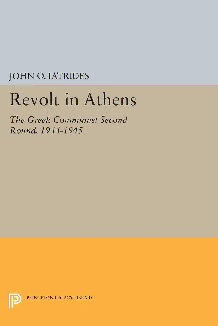
Revolt in Athens: The Greek Communist Second Round, 1944-1945: Greek Communist "Second Round", 1944-45 PDF
Preview Revolt in Athens: The Greek Communist Second Round, 1944-1945: Greek Communist "Second Round", 1944-45
REVOLT IN ATHENS REVOLT IN ATHENS THE GREEK COMMUNIST "SECOND ROUND " 1944-1945 BY JOHN O. IATRIDES With a Foreword by William Hardy McNeill PRINCETON UNIVERSITY PRESS PRINCETON, NEW JERSEY Copyright (c) 1972 by Princeton University Press ALL RIGHTS RESERVED Publication of this book has been aided by a grant from the Ford Foundation LCC: 76-39052 ISBN: 0-691-05203-4 This book has been composed in Linotype Caledonia Printed in the United States of America by Princeton University Press To Nancy CONTENTS ABBREVIATIONS VLU FOREWORD by William H. McNeill ix ACKNOWLEDGMENTS xiv INTRODUCTION 3 I GREEK POLITICAL REALITIES 9 II IN SEARCH OF NATIONAL UNITY 57 III AFTER LIBERATION 132 IV THE STRUGGLE FOR ATHENS 200 V BETWEEN ROUNDS 256 VI IN RETROSPECT 276 APPENDICES 289 BIBLIOGRAPHY 325 INDEX 333 ABBREVIATIONS EAM (Ethnikon Apeleftherotikon Metopon): National Lib- eration Front EDES (Ethnikos Demokratikos Ellinikos Syndesmos): Na- tional Republican Greek League EKKA (Ethniki Kai Koinoniki Apeleftherosis): National and Social Liberation ELAS (Ethnikos Laikos Apeleftherotikos Stratos): National Popular Liberation Army KKE (Kommunistikon Komma Ellados): Communist Party of Greece PEEA (Politiki Epitropi Ethnikis Apeleftherosis): Political Committee of National Liberation x (Khee): Extreme royalist armed group FOREWORD BY WILLIAM H. MCNEILL BOBERT A. MILLKEN DISTINGUISHED SERVICE PROFESSOR OF HISTORY, UNIVERSITY OF CHICAGO ODD THOUGH it may sound, I have experienced the events with which Professor Iatrides deals in this book no less than three times: once as an eyewitness in 1944-45; once as a writer and historian in 1946-47; and now for a third time as a reader in 1970. Each experience carried its own poignancy. As an eyewitness I saw and heard a small part of what took place in Athens during the revolt of December 1944. Some events of greatest import, like the demonstration in Constitution Square on December 3, which touched off large-scale fighting in Athens, manifested themselves as a series of more or less disconnected encounters, separated from one another by periods of quiet when nothing hap pened within the range of my personal observation. In such moments of crisis, normal patterns of communica tion break down; the eyewitness, if he pauses to reflect, must realize how little he really knows about what is going on. But everyone, even high military commanders, is in nearly the same position. For even if the command and communications net functions smoothly, it functions only within the pattern of everyday channels, linking headquar ters with headquarters up and down the line. The desperate confusion "out there," where thousands of angry, frightened people are doing things and having things done to them,
